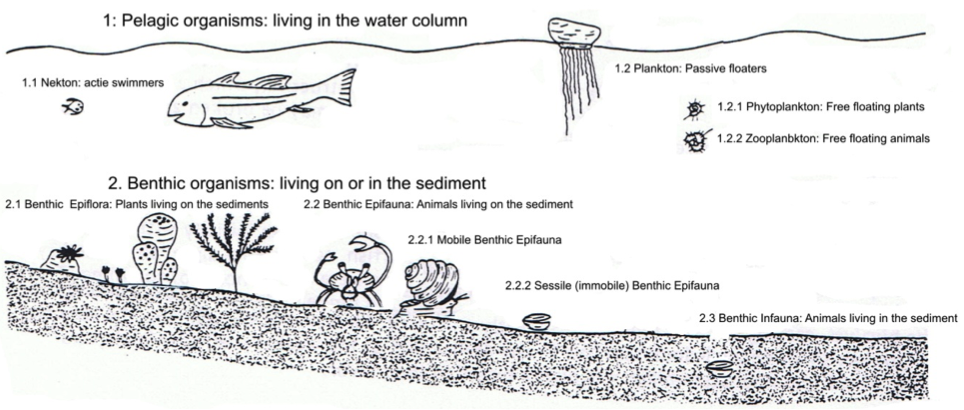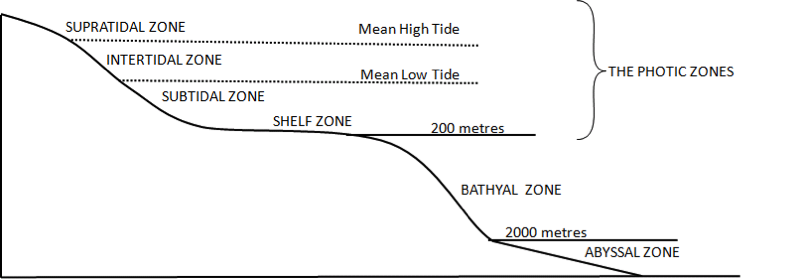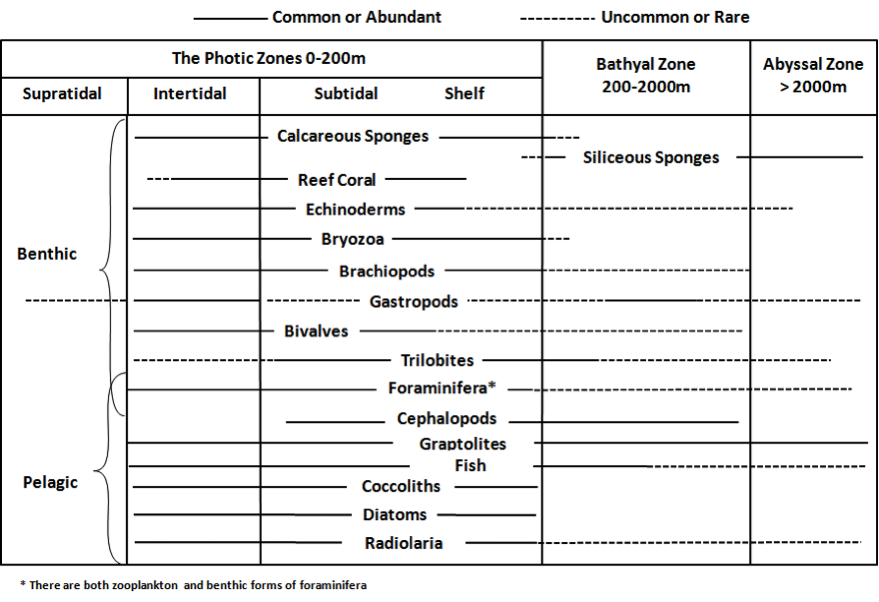Paleoecology
Ecology is the study of modern species diversity, abundance and distribution in space and their relationships with their physical environment. Paleoecology is the study of fossil species and their interrelationships with past environments. Fossils can help us understand the environment in which that sediment formed. Similarly, if we have identified the environment that created a sediment, we can understand how a fossil organism might have lived in the past.
Habit
Organisms within an ecosystem can be described by where they live within an ecosystem, which is described as an organism’s habit. This is an organism’s “address” within an ecosystem. Most of the fossils we will be examining once lived in marine ecosystems, and so we will focus on marine habits. The numbers in brackets in the following paragraphs refer to Figure 7.2, which summarizes these habits.
Organisms living within the water column are pelagic organisms (1). These may actively swim in the ocean (1.1 nekton) or passively float with ocean currents (1.2 plankton). Planktonic organisms can be macro-sized (large) like a jelly, or microscopic, and even single-celled.
Microscopic plankton can be grouped into organisms that photosynthesize and make organic carbons (1.2.1 phytoplankton) or organisms that consume organics (1.2.2 zooplankton). Planktonic organisms may be part of Kingdom Monera (single-celled prokaryotes, including both photosynthesizers and consumers), or the Kingdom Plantae (“plants;” multi-cellular eukaryotic photosynthesizers) and Kingdom Animalia (“animals;” multi-cellular eukaryotic consumers).
Organisms that live on or in the sediment are called benthic (2). These can live on the sediment surface and be either photosynthesizers (2.1 epiflora) or consumers (2.2 epifauna). Those animals that live on the sediment may be mobile (2.2.1 mobile epifauna), or they may rest or be anchored to one location (2.2.2 sessile epifauna). Animals that live within the sediment are termed infauna (2.3).

Environment Ranges
A second level of description is needed to indicate where in the ocean an organism lives, specifically the depth of water and its location relative to shore (Figure 7.2). Distance from shore is related to the energy of the water, and the availability of nutrients that are derived from land. Other physical characteristics that vary between locations include:
- Temperature
- Salinity
- Oxygen content
- Turbidity (sediment carried in the water) or clarity of the water
- Turbulence (motion of the water). The wave-breaking zone or currents would be examples of high turbulence.
- Availability of food

Depth of water determines the amount of light arriving from surface, and also water temperature. Organisms that live close to shore in warm shallow water occupy a very different ecological niche than those living in very deep, cold water.
Photosynthetic plants are restricted to water depths where sunlight can penetrate, and therefore all live within water that is less than 200 m deep. The supratidal, intertidal, subtidal and shelf zones are therefore all photic zones.
Some mobile marine organisms may venture out of the ocean into the supratidal zone. This means they may be exposed to air, or may encounter fresh or brackish (partially salty) water.
Some mobile and anchored benthic organisms live where the tide goes in and out and where they are sometimes exposed to air (intertidal zone). While this is an area of high energy due to waves or currents, it also receives high levels of nutrient loading from land.
A bit farther out, just below the range of the tides, is the subtidal zone. This is still close to shore and nutrient sources, but experiences slightly lower energy.
Further out, the shallower part of the ocean located above the continental shelf is the shelf zone. This area has higher productivity than the open ocean due to the input of nutrients from the adjacent continent, and has less energy than the intertidal and subtidal zones.
Organisms that do not rely upon sunlight can live at any depth and their habitat may extend from the photic zone into the bathyal zone (200-2000m), or into the abyssal zone (2000m+), depending on their food sources and predators.
It is important to note that although the names of the environment range zones may match to sedimentary facies names, the definitions of these environment range zones are distinct. For example, the shelf environment range zone is defined as being the portion of the continental shelf where water depths are 200 m or less. The continental shelf sedimentary depositional environment—and hence the location where you would find the assemblage of sediments that represent a continental shelf facies—is determined by the actual geographic extent of the continental shelf, which may extend to water depths greater than 200 m. The bathyal and abyssal environment ranges zones are also defined by depth, and thus may or may not correspond to the depths of the physical edge of the continental shelf and the toe of the continental slope where the deep basin sedimentary depositional environment and facies would be found.
Figure 7.4 shows the environment ranges of the common phyla introduced in Labs 6 through 8.

Questions a-d
a. Give the terms used for the following life habits:
i. a free-swimming organism
ii. a floating organism
iii. a burrowing organism
iv. an animal organism that lives attached to the sea floor
b. Index (or guide) fossils are used for time-stratigraphic correlation (see Lab 4). Use your class notes from lecture (or the textbook or the internet) to list the four main characteristics of a good index fossil.
c. What one habit would increase the probability that an organism could be used as an index fossil?
d. Why are most benthic organisms not useful as index fossils?
